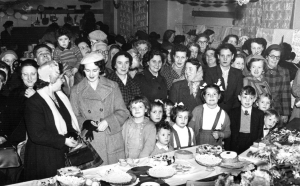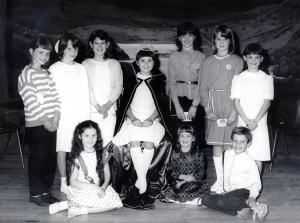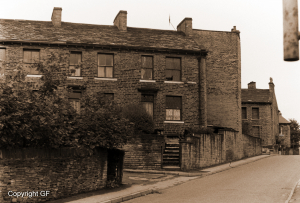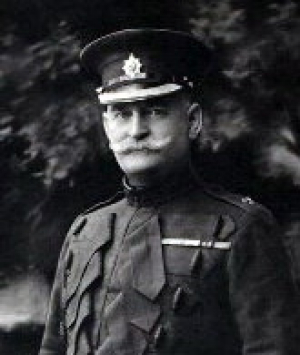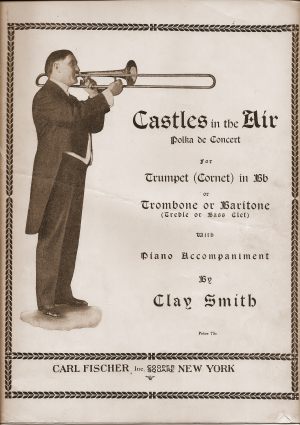
Chris Helme
Margaret Sharp, who died recently, was a local historian and author with an exceptional knowledge of the history of Clifton. She was someone I had known for many years and when ever I needed to find an answer to some detailed and often fairly obscure piece of history about Clifton village or some of its residents from the distant past she was the first person I turned to for help. Her knowledge of the village was almost encyclopedic.
Ernst Stieberitz - b: (Saxony-Anhalt ), May 31,1877 - d: Bohnsack (near Danzig, then Germany, now Gdańsk, Poland), March 27, 1945) he was a German composer, conductor and flautist .
He received his first music lessons at the music school in Camburg on the River Saale. His main instrument was the flute. He started his military career as a flautist on October 1, 1896 in the Military Chapel of the 8. Rheinisches Infantry-Regiment Nr. 70 in Saarbrücken. In 1899, he was moved, together with his conductor to the Military Chapel of the Infantry-Regiment Nr. 128 in Danzig (now Gdańsk). From October 1902 he studied at the Royal Music Academy in Berlin and received training as a Military Bandmaster (Music Meister). He graduated there on July 29, 1905.
On May 1, 1906, he was appointed conductor of the Military Chapel of the Infantry-Regiment Nr. 128 in Danzig (now: Gdańsk), making him the youngest conductor of a military band at the time.
After the First World War he returned to the position of conductor at the Military Chapel of Infanterie-Regiment Nr. 128 in Danzig. In the Prussian Army he was appointed to the rank of a major. Shortly afterwards, the city of Danzig was declared a Free City and all military troops, including the chapel of the Infantry-Regiment Nr. 128 had to get out of town. A police chapel with military structures was established in the Free City of Danzig. It became one of the leading German police chapels.
From 1920 to 1945 he was a conductor and Ober Musik Meister in the rank of a major at the Musikkorps der Polizei der Freistadt Danzig. One of the highlights of this time was a concert with vocal soloists from the Teatro alla Scala from Milan on June 20, 1936 in Sopot (then Zoppot), in which the band of the Danzig police took part.
He died during the bombing of Danzig by the Russian air force in 1945. As a composer he wrote many works for concert band, including over 60 marches.
In this week’s show we feature his march Grup aus Danzig (Greetings from Danzig) which is played by Besses O’ th’ Barn Band and conducted by Roy Newsome in 1983.
Looking back at our household appliances things have certainly moved on a pace since we bought our first home.
Arturo Márquez Navarro (born 20 December 1950) is a Mexican composer of orchestral music who uses musical forms and styles of his native Mexico and incorporates them into his compositions.
He was born in Álamos, Sonora, where his interest in music began. He is the first born of nine children. He was the only one of the nine siblings who became a musician. Because of his father and grandfather, he was exposed to several musical styles in his childhood, particularly Mexican "salon music" which would be the impetus for his later musical repertoire.
He started composing at the age of 16 and then attended the Mexican Music Conservatory, where he studied piano and music theory from 1970 to 1975. Subsequently, he studied composition from 1976 to 1979. In the U.S., he was awarded a Fulbright Scholarship and obtained an MFA in composition in 1990 from California Institute of the Arts in Valencia, California.
His music incorporates forms and styles of his native Mexico (Soto Millán 1996–1998). The Danzones are based on the music of and the Veracruz region of Mexico. Danzón No. 2 was included on the program of the Simon Bolívar Youth Orchestra conducted by Gustavo Dudamel on their 2007 tour of Europe and the United States.
This opened the door for the discovery of other pieces by the composer that are increasingly being performed throughout the world and extensively in Latin America. His Danzones are increasingly being used for ballet productions throughout the world. He is a popular composer among the Latin American public and is widely recognized as one of the most important Mexican composers of his generation.
Arturo Márquez lives with his family in Mexico City.
On this week’s show we have Danzon No. 2 arranged for brass bands by Derek Broadbent
Lots of smiling faces on this photograph back in c1987-1988. This is the occasion of the Sunday School Gala Queen at St Matthew’s Methodist Church.
It was after the hot summer of 1976 / 1977 that I moved from Lincolnshire to Brighouse. After my parents' divorce, Dad moved to Brighouse to be nearer family, and about six months later so did my Mum, my little brother and me.
Church Gate was in Church Lane, Brighouse and along with a number of other streets it was demolished and now forms part of the car park and grassed area at the side of St Martin's Parish Church. In 1912 four houses on Church Gate were occupied Number 1: Ernest Clayton Number 3: William Owen Number 5: Joseph Owen and Number 7: George Walls. Were any of these relatives of yours? Where they were rehoused after these properties is not known.
John Mackenzie-Rogan: b. 27.04.1855 - d. 11.02.1932 he was a British composer and military bandmaster. As a composer he mainly wrote works for concert band, with Bond of Friendship being the best known.
He studied at the Royal Military School of Music ‘Kneller Hall’ in Twickenham from 1880. After graduating he became military bandmaster in 1882 with the 2nd Battalion the Queen's Royal (West Surrey) Regiment Band.
In 1896, as the successor of Cadwallader Thomas, he became conductor of the well-known Band of HM Coldstream Guards in London. He was also Senior Director for the Garde Music Chapels and conducted the United Guards Music Chapels at Queen Victoria 's funeral, coronation celebrations and King Edward VII funeral. The Coronation of King George V.
In 1896 an officer of the Coldstream Garde Regiment brought a copy of the arrangement of Tchaikovsky's 1812 Overture from St Petersburg, Mackenzie-Rogan performed it with the Band of HM Coldstream Guards at concerts all over England. A guest at one of these concerts was the well-known conductor Sir Henry Wood, who greatly appreciated the performance.
The Coldstream Guards Military Music Chapel was the first military army chapel to tour Canada in 1896. In 1907 he was made an honorary doctor of the University of Toronto in Toronto. He was also a Knight of the Order of ther Crown of Belgium and an Officer of the Order of the Black Star since August 1917. He retired in March 1920.
We have his Moray Firth March which he wrote in 1896 on this week’s show. This was written under the name John MacKenzie.
My Sunny Vale book is still selling but heck no one has ever paid £102.09p... It can still be purchased from me direct and through the online shop on this website...at £12.00 + £3 p/p.
Clay Smith was born in 1878 in Greencastle, Indiana. His first documented musical activity involved playing E-flat cornet solos for exhibits at the 1893 Chicago World’s Fair. At some point he became proficient on the saxophone and trombone, which seems to have been his primary instrument for most of his career. His teachers included Alfred F. Weldon, Gardell Simons, and Hale A. VanderCook. He performed with several famous bands, such as the bands of Hi Henry’s Minstrels, Wallace Brothers Circus, the Barnum and Bailey Circus, and the Ringling Brothers Circus. He was also featured trombone soloist at the 1904 St. Louis World’s Fair with Phinney’s Band.
With Guy E. Holmes, Smith formed the Apollo Concert Company, which toured on a vaudeville circuit. About 1914, he organised the Smith, Spring, and Holmes Concert Company, which made several recordings and toured Chautauqua and Lyceum circuits. Smith and Holmes collaborated on many compositions and arrangements for various instruments.
From all accounts, Smith was an accomplished and virtuoso trombone soloist. Many of his works reflect a need for technical and lyrical proficiency. Unlike Arthur Pryor, Leo Zimmerman, and other contemporaries who “headlined” as soloists with the major touring concert bands of the day, Smith spent most of his career on the Chautauqua and theatre circuits. It would appear that Chicago served as his home for at least the latter part of his life. He died there in 1930.
We are featuring his composition Castles in the Air on this show.
Talks Available
All the presentations are timed to last up to an hour except where shown - questions are gladly taken after the presentation. All have been presented to male, female and mixed audiences of varying age groups.
-
A Postcard from the Past
The Sunny Vale Pleasure Gardens, Halifax - Yorkshire’s Alton Towers of the…
-
All in a Days Work
Reminiscences from 30 years in the Police Service – (humorous lecture presentation)…
-
Legends from the world of Brass Bands
(Info-tainment – digital slides & music) – 1 hour presentation.
-
A Week in May
A story based on the Murder of Lord Frederick Cavendish (of the…
- Memories of Christmas Past
-
The Road to Publication
In 1979 I was asked to assist in presenting a series of…
- Holiday Memories from the Past
-
How we used to live
We have all seen and experienced changes in our lives. Bring back…
-
Other Folks Rubbish (Not suited to a Zoom presentation)
With a local history theme… – (thought provoking humorous lecture presentation) –…
- So you want to be a Pirate ? - The life of a Pirate was not all that it seemed
- Superstitions, New Year Resolutions and the Origins of St Valentine's Day
- Brighouse at Work
-
Sorry but I am not able to accept any more face to face talk bookings at the present time ONLY ZOOM TALKS




